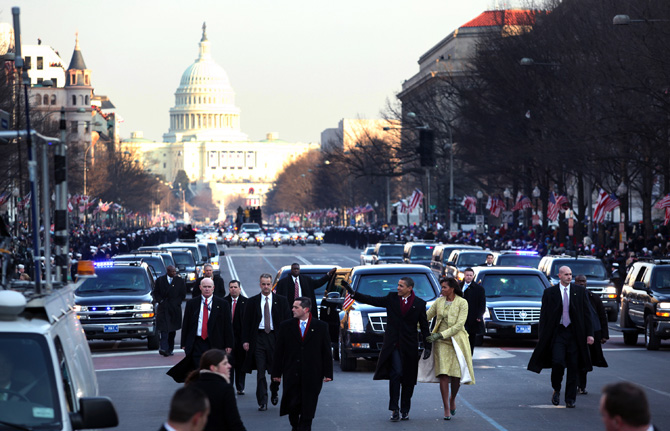Every man elected to the office of President of the United States has historically been involved in an inauguration, opens a new window. Sometimes, that merely includes a swearing-in, in which the incoming President and Vice President are given the Oath of Office by a judicial officer. This happens most often when a Vice President must be sworn in after the death or other form of departure by a standing president; Theodore Roosevelt was sworn in at a friend's house in Buffalo. In more usual situations, it includes a days-long celebration including the swearing in ceremony for both officials, performances, poetry, speeches, meals, and parties. Not to mention the parade, involving members of the military and civilian organizations from across the United States.
There are two parts of the presidential inauguration: the ceremony and the celebration. Until the inauguration of Ronald Reagan (starting with Andrew Jackson, opens a new window), the presidential inauguration ceremony was held on the Capitol’s East Portico and Front. But it’s now on the West Portico to provide space on the National Mall for all who wish to be present. Following the ceremony, which includes the swearing-in, speeches, and a few songs, the newly sworn President and Vice President, along with their families, process down Pennsylvania Avenue to the White House, where they then watch the inaugural parade from a shiny glass box on the North Lawn of the White House. This originally began as a review of the nation's military, but has since become a combined military and civilian parade featuring marching bands and other parade marchers and paraphernalia.
And now, some Inauguration trivia:
The first presidential inauguration, opens a new window of George Washington, opens a new window was held on the balcony of Federal Hall in New York in 1789.
For most of the past century, the official swearing-in has taken place on January 20. If that is a Sunday, the President and Vice President are sworn in privately on the 20th and the big inaugural celebration is held on the following Monday.
President Abraham Lincoln, opens a new window's second inauguration in 1865 was the first time African-Americans participated in the inaugural parade.
Fifty-four addresses have been given by thirty-seven presidents. George Washington's second address was the shortest (135 words), and William Henry Harrison delivered the longest (8,495 words).
Contrary to legend, William Henry Harrison, opens a new window, who, yes, opted not to wear an overcoat or hat to an outdoor ceremony and procession in early March, and then proceeded to give the longest inaugural speech in American History, did not catch a cold and die until three weeks after said address. It makes a good story, though.
 The fourth inauguration of Franklin D. Roosevelt, opens a new window (the only president ever to be elected four times) was held on the South Portico of the White House to cut costs and comply with austerity measures during World War II. There was no parade or other celebration.
The fourth inauguration of Franklin D. Roosevelt, opens a new window (the only president ever to be elected four times) was held on the South Portico of the White House to cut costs and comply with austerity measures during World War II. There was no parade or other celebration.
The inauguration of President Barack Obama, opens a new window was the largest-attended event in the history of Washington, D.C. It also included many firsts, including first woman emcee and the first inauguration webcast to be made accessible by using captioning.
Read more about the history of inauguration in America:
Presidential Inaugurations in Academic OneFile, opens a new window
Presidential Inaugurations in Infotrac International Newsstand, opens a new window
Presidential Inaugurations in the National Archives, opens a new window
What’s your first inaugural memory?


